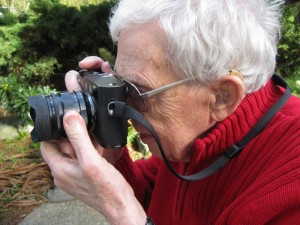Legendary Canadian photographer Ted Grant will tell you he’s had a roving eye for most of his life. And even though the years are adding up, he’s still got it. His iconic photos, like his stories, span decades of history, which he retells in characteristic, snapshot-like sentences.
“I always had some kind of feeling for it,” he says. “My father used to take pictures and he’d say to me, ‘Come over here and look,’ and let me have a look through the lens of his box Brownie camera.”
In 1950, Ted’s wife, Irene, bought him an Argus A2 35mm, and a lifetime behind the lens began. Given that he ended up taking several iconic photos—a smiling Jacquie Kennedy, Pierre Elliott Trudeau flying down a banister, and Mike Tewksbury biting on his gold medal, to name a few—it was obviously the right decision.
“I couldn’t wait to get outside and start taking pictures,” he says, thinking back fondly on when it all began.

Even though Grant, who will be speaking at UVic on Saturday, has been around long enough to be known as the father of Canadian photojournalism, as the industry advanced, so did he. Transitioning from the dark room to digital was easy for Grant.
“I took to digital right away,” he says. “With film you could miss the shot changing rolls, but with digital you can shoot 2,000 or 3,000 pictures.”
According to Grant, photography assignments have changed, and so have photographers. Mainly, there are not as many assignments for them to get anymore.
“Now anyone who owns an iPhone can hold it up, go click, click, click, and send it in,” he says. “With the economy what it is, the rags get this stuff for free and it’s putting good photographers out of work because they arrive at the news after it happens.”
This new reality for photographers is a lot different than how things were in Grant’s day. Dan Doherty, who has taught photography classes at Camosun, suggests industry standards have lowered compared.
“A photojournalist like Grant used an artist’s eye, foresight and planning, and a certain amount of luck,” says Doherty. “With something like the Vancouver riots, are those shots iconic due to a luck shot or the eye of an experienced journalist? Even copyright laws have changed to reflect these trends. I’m all for radical democracy and still have to make a living, but all this free photography might lead to an overall enrichment of society.”
Grant says that one way things have changed is that he used to be sent out on weekly assignments to chase down a story, often on just a thin thread of an idea.
“I’d be told, ‘They’re doing something in wood out there in British Columbia, go out there and find out what,’” he says.
And the best way to find out what that “what” is? According to Grant, it’s simple.
“Just start at the beginning,” he says, “and shoot your way through until it’s all over.”
Which is exactly how he got that famous shot of Trudeau.
“I was leaving the Chateau Laurier hotel,” Grant remembers. “All the other media had gone outside to wait by his car. I’m still inside and starting down the stairs ahead of him. I heard people begin to laugh, I turned around, the camera went up and, click. A quick focus, a click—I got two more frames in and he was on top of me,” he says with a chuckle.
“The media were all pressed up against the glass trying to get back in but couldn’t because the doors opened outwards,” he continues. “But it wouldn’t have made any difference. Trudeau never did anything like that twice.”
The Silent Observer: A Talk with Ted Grant
Saturday, March 10, 2 pm
MacPherson Library A003, University of Victoria
maltpub@finearts.uvic.ca
